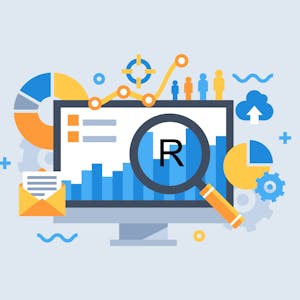Data Visualization with R
In this course, you will learn the Grammar of Graphics, a system for describing and building graphs, and how the ggplot2 data visualization package for R applies this concept to basic bar charts, histograms, pie charts, scatter plots, line plots, and box plots. You will also learn how to further customize your charts and plots using themes and other techniques. You will then learn how to use another data visualization package for R called Leaflet to create map plots, a …
Data Visualization with R
In this course, you will learn the Grammar of Graphics, a system for describing and building graphs, and how the ggplot2 data visualization package for R applies this concept to basic bar charts, histograms, pie charts, scatter plots, line plots, and box plots. You will also learn how to further customize your charts and plots using themes and other techniques. You will then learn how to use another data visualization package for R called Leaflet to create map plots, a unique way to plot data based on geolocation data. Finally, you will be introduced to creating interactive dashboards using the R Shiny package. You will learn how to create and customize Shiny apps, alter the appearance of the apps by adding HTML and image components, and deploy your interactive data apps on the web.You will practice what you learn and build hands-on experience by completing labs in each module and a final project at the end of the course.
Watch the videos, work through the labs, and watch your data science skill grow. Good luck!
NOTE: This course requires knowledge of working with R and data. If you do not have these skills, it is highly recommended that you first take the Introduction to R Programming for Data Science as well as the Data Analysis with R courses from IBM prior to starting this course. Note: The pre-requisite for this course is basic R programming skills.
Create bar charts, histograms, pie charts, scatter plots, line graphs, box plots, and maps using R and related packages.
Design customized charts and plots using annotations, axis titles, text labels, themes, and faceting.
Create maps using the Leaflet package for R.
Create interactive dashboards using the Shiny package for R.
Syllabus
Syllabus - What you will learn from this course
Week 1
Module 1 - Introduction to Data Visualization
Data without a way to convey the story behind it to yourself or others is just numbers on a page. You can observe and tell the story of your data in a more impactful way through visualization.
Week 2
Module 2 - Basic Plots, Maps, and Customization
In this module, you will learn the basics of data visualization using R, including the fundamental components that are shared by all charts and plots, and how to bring those components to life using the ggplot2 package for R. You will also learn how to create three common chart types, including bar, histogram, and pie charts, from the qualitative and quantitative data.
Week 3
Module 3 - Dashboards
In this module, you will take your data visualization skills to the next level! You will learn how to create three plot types, including scatter plots, line, plots, and box plots, using the ggplot2 library and then customize the visualizations using annotations and customized axis titles and text labels. You will also learn about faceting, a way to visualize each level of a discrete or categorical variable, and different ways to work with themes. Finally, you will learn about a unique chart type called a map that you can create using geolocation data and the Leaflet library.
Week 4
Module 4 - Final Assignment
Your data tells a story. You have built the charts and plots that show important relationships between variables, identify outliers and anomalies, and see the trends that can help you predict what the future might bring. Now you want to put these insightful data visualizations at the fingertips of your stakeholders and make it easy to interact with and explore the data. You need a dashboard!
FAQ
When will I have access to the lectures and assignments?
Access to lectures and assignments depends on your type of enrollment. If you take a course in audit mode, you will be able to see most course materials for free. To access graded assignments and to earn a Certificate, you will need to purchase the Certificate experience, during or after your audit. If you don't see the audit option:
The course may not offer an audit option. You can try a Free Trial instead, or apply for Financial Aid.
The course may offer 'Full Course, No Certificate' instead. This option lets you see all course materials, submit required assessments, and get a final grade. This also means that you will not be able to purchase a Certificate experience.
What will I get if I subscribe to this Certificate?
When you enroll in the course, you get access to all of the courses in the Certificate, and you earn a certificate when you complete the work. Your electronic Certificate will be added to your Accomplishments page - from there, you can print your Certificate or add it to your LinkedIn profile. If you only want to read and view the course content, you can audit the course for free.
Reviews
Dear Professors.
Thank you for sharing your knowledge. I learned a lot in this course, especially regarding ggplot and shiny. I got to make my first APP and this was really good. Thank you!
high efficieny course which provide knowlegde about the course .
It is an amazing course. But you should know the basics of the Rstudio and it's layout.
The course was good and the videos explained the topic very well and the content was indeed very nice..thanks for providing such a good course
Start your Free Trial
Self paced
7,917 already enrolled
4.6stars Rating out of 5 (110 ratings in Coursera)
Go to the Course
